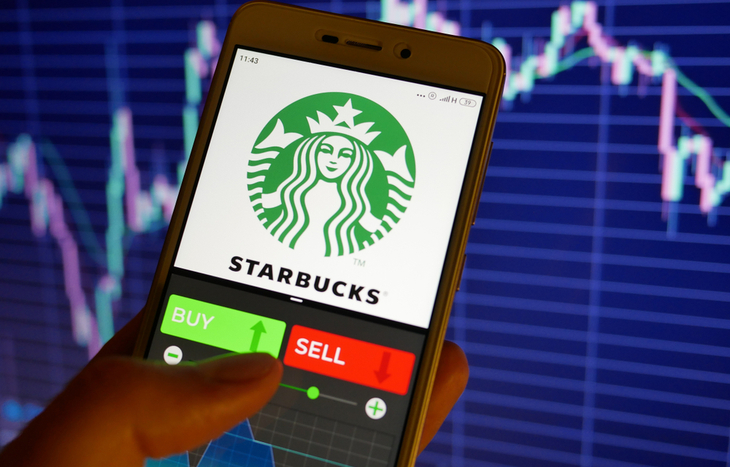Starbucks’ Financial Performance: Sbux Stock

Starbucks, the coffee giant, has been brewing up impressive financial results in recent years. The company’s commitment to innovation, global expansion, and customer loyalty has propelled its growth and profitability.
Revenue Growth
Starbucks’ revenue has been consistently growing, fueled by its global expansion, new product launches, and a loyal customer base. In recent years, the company has opened new stores in emerging markets and expanded its product offerings to include healthier options and premium beverages. This has resulted in a steady increase in revenue, which has outpaced the growth of the overall coffee industry.
Profitability
Starbucks has maintained strong profitability, thanks to its efficient operations, effective cost management, and strong brand recognition. The company has been able to generate significant profit margins, even as it has invested heavily in growth initiatives. Starbucks’ focus on innovation and customer experience has helped it maintain its pricing power, allowing it to charge premium prices for its products.
Cash Flow
Starbucks generates significant cash flow from its operations, which allows it to fund its growth initiatives, return value to shareholders through dividends and share buybacks, and manage its debt. The company’s strong cash flow is a testament to its efficient operations and its ability to generate consistent revenue.
Comparison to Peers
Starbucks’ financial performance has consistently outpaced its peers in the coffee industry. The company’s strong brand recognition, global reach, and focus on innovation have allowed it to maintain its market leadership position. Compared to other coffee chains, Starbucks has higher revenue, profit margins, and cash flow.
Factors Driving Performance
Several factors have contributed to Starbucks’ strong financial performance:
- Global Expansion: Starbucks has expanded its presence in emerging markets, tapping into new customer bases and driving revenue growth.
- Product Innovation: The company has introduced new products, such as plant-based options and premium beverages, to appeal to a wider range of customers.
- Loyalty Program: Starbucks’ rewards program has been highly successful in driving customer loyalty and repeat purchases.
Cost Management
Starbucks has been effective in managing its costs and expenses. The company has focused on streamlining its operations, optimizing its supply chain, and negotiating favorable terms with its suppliers. Starbucks has also invested in technology to improve efficiency and reduce costs.
Debt Levels and Servicing
Starbucks maintains a manageable level of debt, which it uses to fund its growth initiatives. The company has a strong track record of servicing its debt, and its debt levels are not considered a significant risk to its financial health.
Starbucks’ Growth Strategy

Starbucks’ growth strategy is a multi-faceted approach that focuses on expanding its global reach, introducing new products and experiences, and leveraging technology to enhance customer engagement. The company aims to maintain its position as a leading coffeehouse chain while adapting to evolving consumer preferences and market trends.
Expansion Plans
Starbucks has a long history of expanding its global footprint. The company’s expansion strategy involves opening new stores in both established and emerging markets. Starbucks focuses on strategic locations with high foot traffic and potential for growth. Starbucks also leverages strategic partnerships with local businesses and franchisees to accelerate its expansion efforts.
New Product Launches
Starbucks is constantly innovating and introducing new products to keep its menu fresh and appealing to customers. The company’s new product launches are driven by consumer trends, seasonal preferences, and collaborations with other brands. Starbucks’ product development team is constantly experimenting with new flavors, ingredients, and formats to create exciting and unique offerings.
Digital Initiatives
Starbucks has embraced digital technologies to enhance the customer experience and drive growth. The company’s digital initiatives include mobile ordering and payment, loyalty programs, personalized recommendations, and data-driven insights. Starbucks’ digital platforms allow customers to customize their orders, earn rewards, and receive personalized offers.
Key Growth Opportunities
Starbucks has several key growth opportunities in the coming years. These opportunities include:
- Expanding into new markets, particularly in Asia and Africa, where coffee consumption is growing rapidly.
- Developing new product categories, such as plant-based beverages and healthier food options, to cater to evolving consumer preferences.
- Investing in technology to enhance the customer experience, such as personalized recommendations, mobile ordering, and contactless payment.
- Strengthening its loyalty program and leveraging data analytics to better understand customer behavior and preferences.
Risks and Challenges
Starbucks faces several risks and challenges associated with its growth strategy. These include:
- Increased competition from other coffeehouse chains and independent coffee shops.
- Fluctuations in commodity prices, particularly for coffee beans, which can impact profitability.
- Changing consumer preferences, such as a growing preference for healthier and more sustainable options.
- Economic downturns, which can impact consumer spending on discretionary items like coffee.
Comparison to Competitors
Starbucks’ growth strategy is similar to that of its major competitors, such as Dunkin’ Donuts and McDonald’s. All three companies are focused on expanding their global reach, introducing new products, and leveraging technology to enhance the customer experience. However, Starbucks has a more premium brand image and a greater focus on sustainability.
Optimizing Growth Strategy, Sbux stock
Starbucks can optimize its growth strategy by:
- Continuing to invest in innovation and product development to stay ahead of the competition.
- Expanding into new markets, particularly in Asia and Africa, where coffee consumption is growing rapidly.
- Leveraging technology to enhance the customer experience, such as personalized recommendations, mobile ordering, and contactless payment.
- Focusing on sustainability initiatives to appeal to environmentally conscious consumers.
Starbucks’ Competitive Landscape

The coffee industry is a fiercely competitive market, with Starbucks facing a multitude of rivals vying for consumer attention and market share. This section delves into the competitive landscape, examining Starbucks’ main competitors, its competitive advantages and disadvantages, and the threats it faces.
Main Competitors
Starbucks faces competition from various players across different segments of the coffee market. Its main competitors include:
- Specialty Coffee Chains: These include chains like Dunkin’ Donuts, Peet’s Coffee, and Costa Coffee, which offer a similar experience to Starbucks but often at lower price points.
- Fast-Food Restaurants: McDonald’s, Burger King, and Subway have expanded their coffee offerings, leveraging their existing customer base and infrastructure to compete in the coffee market.
- Independent Coffee Shops: A plethora of independent coffee shops cater to niche customer segments, offering unique blends, artisanal brewing methods, and a personalized experience.
- Grocery Stores and Convenience Stores: Retail giants like Walmart, Target, and 7-Eleven offer a wide range of coffee products, including pre-packaged coffee, single-serve pods, and freshly brewed coffee, providing consumers with a convenient and affordable option.
Competitive Advantages and Disadvantages
Starbucks boasts several competitive advantages that have contributed to its success:
- Strong Brand Recognition and Loyalty: Starbucks has cultivated a strong brand image, synonymous with premium coffee and a unique customer experience. This brand loyalty translates into a significant customer base and consistent sales.
- Extensive Store Network: Starbucks has a vast global footprint, with over 34,000 stores in 80 countries, providing convenient access for customers worldwide.
- Product Differentiation: Starbucks offers a wide range of coffee beverages, pastries, and other food items, catering to diverse tastes and preferences.
- Focus on Customer Experience: Starbucks prioritizes customer service and provides a welcoming atmosphere, fostering a sense of community and belonging.
However, Starbucks also faces some disadvantages:
- Higher Price Point: Starbucks’ premium pricing strategy can be a barrier for price-sensitive customers, especially in the face of cheaper alternatives.
- Limited Customization: While Starbucks offers some customization options, its menu is largely standardized, which may not appeal to customers seeking unique or personalized beverages.
- Competition from Smaller, More Agile Players: Smaller coffee shops and independent roasters can adapt more quickly to changing trends and consumer preferences, offering a more personalized and niche experience.
Competitive Threats
Starbucks faces several competitive threats:
- New Entrants: The coffee industry is attracting new entrants, including startups and established brands expanding into the coffee market. These new players can disrupt the market by introducing innovative products, pricing strategies, and customer experiences.
- Substitute Products: Consumers have various alternatives to traditional coffee, such as tea, energy drinks, and other beverages. The growing popularity of these substitutes can erode Starbucks’ market share.
- Bargaining Power of Buyers: Consumers have increasing choices and access to information, making them more discerning and price-sensitive. This gives them greater bargaining power, potentially impacting Starbucks’ pricing strategies.
- Bargaining Power of Suppliers: Starbucks relies on suppliers for key ingredients, such as coffee beans and dairy products. Fluctuations in commodity prices and supplier concentration can impact Starbucks’ profitability.
Strategy for Maintaining Competitive Advantage
To maintain its competitive advantage in the long term, Starbucks needs to adopt a multifaceted strategy:
- Innovation and Product Development: Starbucks must continue to innovate and introduce new products and services to meet evolving consumer tastes and preferences. This includes experimenting with new coffee blends, brewing methods, and beverage formats, as well as expanding into complementary categories like tea, smoothies, and cold-pressed juices.
- Customer Experience Enhancement: Starbucks needs to enhance its customer experience by leveraging technology, offering personalized recommendations, and creating a more engaging and interactive environment in its stores. This can include implementing mobile ordering, loyalty programs, and personalized digital experiences.
- Cost Management: Starbucks must manage its costs effectively to remain competitive in a price-sensitive market. This includes optimizing its supply chain, negotiating favorable supplier agreements, and streamlining operations.
- Brand Management: Starbucks needs to maintain its brand image and reputation by focusing on ethical sourcing, environmental sustainability, and social responsibility. This can include initiatives to promote fair trade coffee, reduce its environmental footprint, and support local communities.
Competitive Analysis Table
| Feature | Starbucks | Dunkin’ Donuts | Peet’s Coffee | Costa Coffee |
|---|---|---|---|---|
| Price | Premium | Value-oriented | Premium | Mid-range |
| Product Offerings | Wide range of coffee beverages, pastries, and food items | Coffee, donuts, breakfast sandwiches, and other food items | Specialty coffee, tea, and pastries | Coffee, tea, and pastries |
| Customer Experience | Focus on premium experience, welcoming atmosphere, and personalized service | Convenient and quick service, value-oriented experience | Emphasis on quality and craft coffee, upscale ambiance | Similar to Starbucks, but with a more European flair |
| Brand Image | Premium, sophisticated, and global | Value-driven, everyday coffee experience | Artisan, high-quality coffee | European coffeehouse experience, known for its lattes and cappuccinos |
Sbux stock has been on a rollercoaster lately, mirroring the overall market volatility. It’s interesting to see how other fast-casual giants like Chipotle are navigating this landscape. The ceo of Chipotle has been making bold moves to ensure their continued success, and their stock performance has reflected that.
It’ll be interesting to see how Sbux adapts to the changing consumer landscape and what strategies they implement to stay competitive.
SBUX stock has been on a rollercoaster ride lately, but investors are always looking for clues to its future direction. One interesting parallel is the starbucks chipotle comparison, highlighting the potential for both companies to navigate changing consumer tastes and economic challenges.
While Starbucks has a more established footprint, Chipotle’s focus on fresh ingredients and customization could offer valuable lessons. Ultimately, SBUX’s stock performance hinges on its ability to adapt and innovate, just like Chipotle has done.